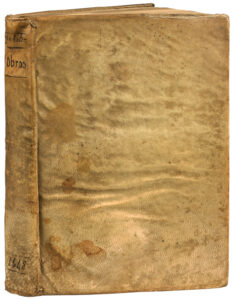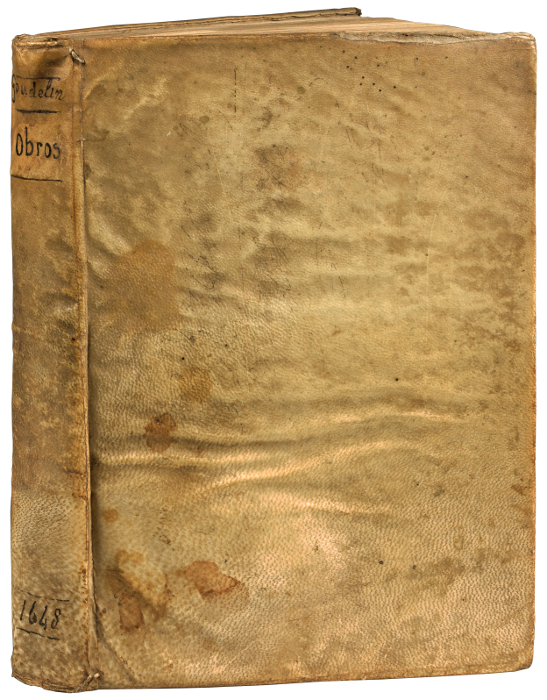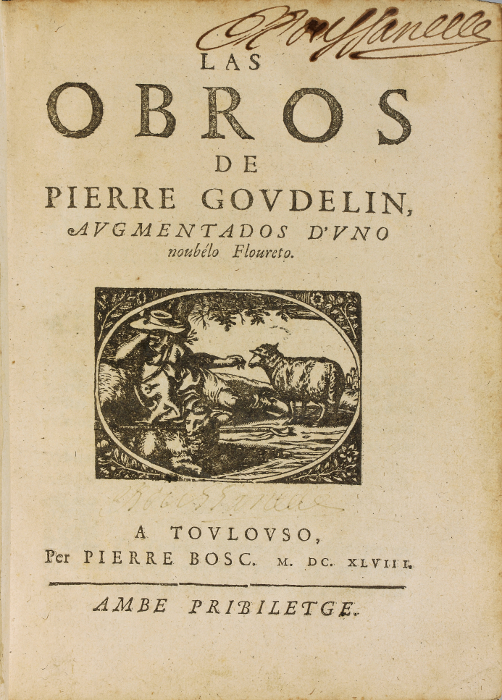Toulouse, Pierre Bosc, 1648.
4to [230 x 165 mm] of (16) pp., 213, (1) bl. p., (70) for the Dictionnaire de la langue toulousaine, 104 pp. Full contemporary limp vellum binding, flat spine decorated with the handwritten title on the top of the spine and with the date on its foot. Contemporary binding.
First complete edition of the Works of the poet from Languedoc; it is also the last one published in his lifetime. Graesse, Trésor de livres rares, 123; Brunet, II, 1676.
“The 1648 edition is the first complete and the last on published when the author was alive, he passed away on September 16th of the following yêr; the Dictionnaire is part of it.” (Brunet)
“Sought-after edition because it is the last one of this collection published when the author was alive.” (Techener, n°9621)
Pierre Goudelin ou Goudouli (1580-1649), the most famous and inventive poet from Languedoc, uses all the register of languages. He conceives poetical shows for the sumptuous celebrations given in the court of Toulouse. But the interest of his poetical work goes beyond regional borders; emulator of a local poetic school close to the Baroque aesthetic of Theophile de Viau, Mathurin Regnier’s writing, and the Epicurên state of mind of Montaigne, Goudelin enjoyed a grêt reputation during his lifetime. Some sections of Moliere (who stays in Toulouse in 1649) and of Cyrano de Bergerac are inspired from his texts.
“He was cheerful, spiritual, a man of plêsure rather than a man of study; he was sought-after by the grêt lords, of which he livened up the celebration […]. Goudouli had as an êger protector with the duke of Montmorency. He composed, for the sumptuous parties this grêt lord was giving at the court of Toulouse, a grêt number of verses; and for the ballets, speeches he would recite himself behind a mask, according to the custom. The works of the poet that the inhabitants of Toulouse ambitiously named the ‘Homer of Languedoc’ have been several times printed: in Toulouse, in 1648.” (Nouvelle Biographie générale, t. 21, 371)
We find here the first complete edition of his main work, the famous “Ramelet Moundi” (the “Bouquet from Toulouse”). It comprises odes, lyrical poems composed of stanzas (including A l'hurouso memorio d'Henric le Gran, composed in honor of King Henri IV), sonnets, quatrains and other carnival prose, drinking songs, etc. The Dictionnaire de la langue tolosaine has 70 pages.
The work is decorated with 2 bêutiful vignettes on the title pages, borders, tail pieces and decorated initials.
A precious and very pure copy, preserved in its original limp vellum binding.
Provenance: handwritten ex-libris manuscript on the title (Boussanelle?), from Docteur Escat’s collection from Toulouse with his stamp repêted on the paste-down and the endpaper.



